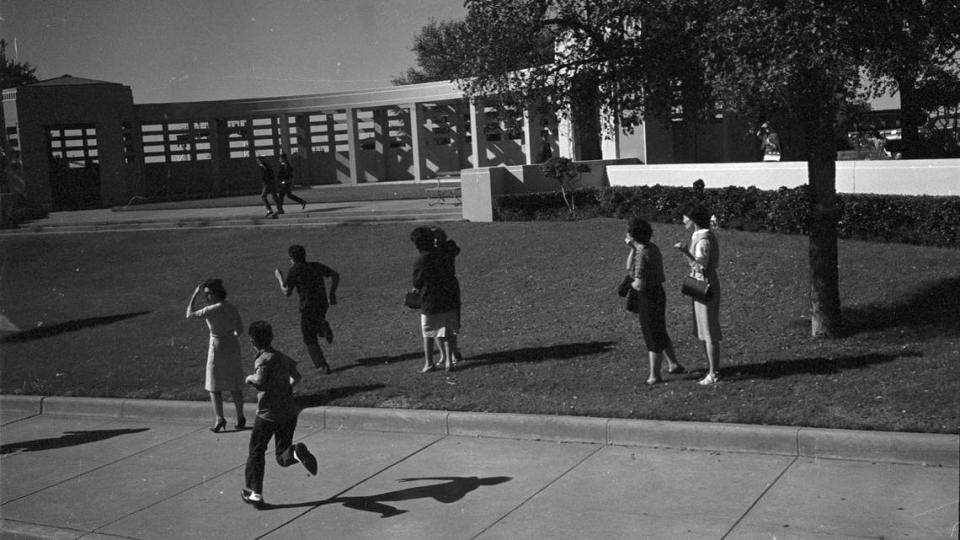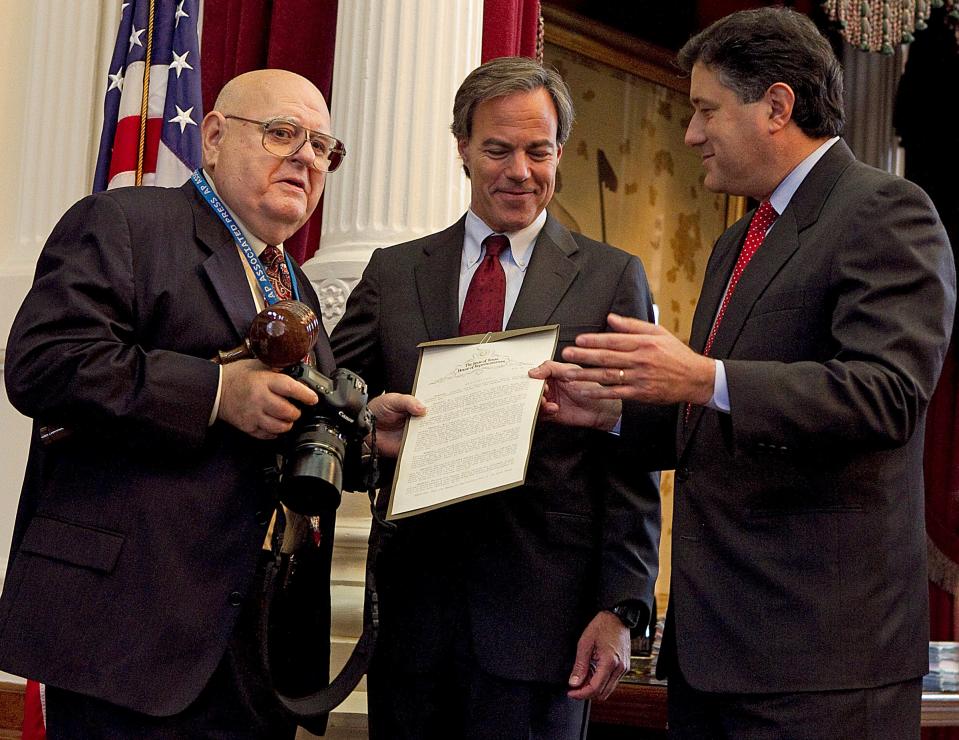Retired news photographer who covered JFK killing contrasts it with Trump shooting
- Oops!Something went wrong.Please try again later.
- Oops!Something went wrong.Please try again later.
- Oops!Something went wrong.Please try again later.
- Oops!Something went wrong.Please try again later.
When retired Texas news photographer Harry Cabluck — one of the few people in President John F. Kennedy's motorcade on Nov. 22, 1963, who are still alive — watched Saturday's television coverage of the attempt on Donald Trump's life, his mind did not wander back to that dark day in Dallas so many years earlier.
Instead, in an interview Sunday, Cabluck marveled at the intensity and poise of the photojournalists whose job it was to capture the up-close still images and videos that told the story of the fear and confusion around the stage in Butler, Pa., in real time and for generations to come.
"He did not flinch," said Cabluck, who is now 86 and lives in Austin, referring to Associated Press photographer Evan Vucci. "Everybody else got down, but he ran to one side and shot pictures. He knew that the escape route from the podium would be to the other side, so he ran to the other side and got between Trump and the limousine.
"He was a pool photographer doing his job."
Vucci and several photographers from Reuters and other news outlets were able to get photos of the instant Trump reacted to being wounded and the frantic efforts by Secret Service agents to protect him. There were no such opportunities in the moving Kennedy motorcade, said Cabluck, who was a young photographer working for his hometown newspaper, the Fort Worth Star-Telegram, when he was assigned to cover the presidential visit.
Like most of the other journalists in the motorcade that rolled through downtown Dallas during the autumn day's lunch hour, Cabluck was riding in the press bus several cars behind the now-iconic, top-down Lincoln Continental carrying the president and first lady Jacqueline Kennedy along with then-Texas Gov. John Connally and his wife, Nellie. Connally was seriously wounded but survived.
The only images Cabluck could capture from the press bus showed the scramble at the infamous grassy knoll near the assassination site. Instead of following the Lincoln to Parkland Memorial Hospital, where the 35th president would be pronounced dead from a gunshot wound, the press bus went on to its planned destination, the Dallas Trade Mart, where Kennedy was to give a speech.
Cabluck, who would spend much of his long career with AP — the last several years at its Capitol bureau in Austin before retiring in 2009 — knew the Trade Mart was not where the story was. So he and a Star-Telegram reporter had to improvise.
More: Longtime photographer plans to keep on clicking
"We ran out on Stemmons Freeway and flagged down a woman driving a car and said, 'Drive us to the nearest hospital,’ ” he recalled. "And she drove us to Parkland, and of course, that's where the action was."

There are some similarities to the shooting at the Trump event, which left one rallygoer dead and others wounded. The Trump shooter, identified as 20-year-old Thomas Matthew Crooks of Bethel Park, Pa., had a high-ground vantage point similar to that of Lee Harvey Oswald when he shot Kennedy in Dallas nearly 62 years ago.
Both men were perched high above their targets and apparently did not attract Secret Service suspicion, although the reports say the Trump shooter was aiming from a distance twice as far as Oswald, who in the sixth-floor window of the Texas School Book Depository was about 90 yards from Kennedy's moving limousine.
Because Trump was speaking on a stage, Secret Service agents were able to swiftly shield him after he ducked to the ground once being wounded. Kennedy had no such protection when the first shot rang out, leaving his assassin a clear view to fire the mortal round.
Still, in both shootings witnesses told authorities they had seen the gunman in position on the roof of a nearby building even though law enforcement had not.
In a late-night news briefing Saturday, Lt. Col. George Bivens of the Pennsylvania State Police said law enforcement was following up on a “number of suspicious occurrences.” Among them were accounts from witnesses who said they had tried to flag police about the activity of a person outside the rally moments before the shooting.

A Dallas witness to the Kennedy assassination, steamfitter Howard Brennan, told the Warren Commission that he had been sitting on a concrete wall waiting for the motorcade about 120 feet from the School Book Depository and that he had seen a man in the sixth-floor window before the shooting. He described the first blast as sounding like a "firecracker," as many of those at the Trump rally would tell reporters.
"Well, then something, just right after this explosion, made me think that it was a firecracker being thrown from the Texas Book Store," Brennan is quoted as saying in the report compiled by the presidential panel tasked with investigating the president's murder. "And I glanced up. And this man that I saw previous was aiming for his last shot.
"Well, as it appeared to me he was standing up and resting against the left window sill, with gun shouldered to his right shoulder, holding the gun with his left hand and taking positive aim and fired his last shot. ... He drew the gun back from the window as though he was drawing it back to his side and maybe paused for another second as though to assure himself that he hit his mark, and then he disappeared."
The scramble and confusion that immediately followed the Dallas shooting were in contrast to the swift action at the Trump rally, Cabluck said, where agents quickly shot and killed the man suspected with firing on Trump just days before the Republican National Convention in Milwaukee.
"I didn't draw any comparisons," Cabluck said about his initial reaction to the shooting in Pennsylvania. "And I still don't."
This article originally appeared on Austin American-Statesman: How JFK, Trump shootings are similar and how they differ

